Proposal:Power paths refinement
| Power paths refinement | |
|---|---|
| Proposal status: | Abandoned (inactive) |
| Proposed by: | Fanfouer |
| Tagging: | power=
|
| Statistics: |
|
| Rendered as: | Identical to power=line and power=cable
|
| Draft started: | 2015-01-30 |
| RFC start: | 2015-01-30 |
Proposal
This proposal aims to clarify the current usage of the power=* key in electricity transmission context and replace some other obsolete values such as power=minor_line.
Proposal content is a part of Proposed_features/Power_transmission_refinement which became too large to be voted as such. Knowledge about power networks can be difficult to handle. It is recommended to look at examples to better understand what is proposed.
Basic Mapping
Large above ground power transmission towers and their conductors are common navigational references (used by hikers and pilots for example). These facilities are widely mapped. Draw one line to represent the wires hanging off a string of poles, then add nodes along the line to represent towers. When mapping from an air photo it is often helpful to look for the shadow cast by each tower: the node should placed at the intersection of the shadow and the apparent base of the tower.
- For major transmission lines: draw a line in OpenStreetMap and tag it
power=line, and addpower=towerorpower=poleon nodes representing towers or poles. - Use only one line in OpenStreetMap, even if there are multiple wires on a string of poles. Additional tagging for number of conductors (wires) is optional and described below.
- Small and roadside distribution lines (particularly those with poles no taller than a wooden electrical pole) are not widely mapped. If mapped, tag the line with
power=lineas major lines, and for the pole nodes usepower=pole. - If known, add
operator=*to say who is operating the line.owner=*may be different. - If known, add
voltage=*. - Don't create relations for power lines. Power lines have to be represented with

power=lineorpower=cableonly.
Rationale
Definitions
Wikipedia and IEC define power transmission infrastructures in these terms:
- A power line (601-03-03, also referred as an electric line) is an arrangement of cables for transferring electricity between sources and loads. A power line may be consists in multiple circuits.
- A cable (461-06-01) is an assembly of several conductors insulated within an assembly protection. It is generally designed to carry power underground.
- A circuit is a set of conductors bundle, 1 for each phase of a multiple phase system and 1 for neutral if present. It is designed for transmitting a given power between two point of a system.
- A bundle (466-10-20) is an assembly of several conductors which is the base item of all stuff exposed here.
- A conductor (466-10-21) is an element which carries electric current. It has often a very bigger length than his cross-section dimensions (e.g. copper wire).
- A neutral conductor ( 826-14-07 826-14-07) is a special conductor connected to the neutral point in a polyphase system. It can contribute to power distribution (and be part of a circuit) if present. Most of time in industrial power transmission systems, the earth is the ground conductor and circuits are only composed of phase conductors.
- A ground conductor (466-10-25) is a security element which carries default electric currents or even lightning strokes when aerial. It can be grounded on every support or just regularly all along the line or cable path. It doesn't carry any current when line or cable are running normally and can't be part of a circuit.
- Voltage (121-11-27) is the electric potential difference between two points and it's measured in volts.
- A power tower (466-08-01) is a support which may be made of such material as steel, wood, concrete, and comprising a body which is normally four-sided, and cross-arms.
- A power pole (466-07-01) is a vertical single member support in wood, concrete, steel or other material, with one end buried in the ground.
- Power transmission (601-01-09) is bulk transfer of energy from power plants to consumption places.
- Power distribution (601-01-10) is the transfer of energy to consumers inside a consumption place.
OSM usages
The best way to use them in OSM is to keep those simple definition and build a consistent tagging model.
It's not what is currently used, overhead and underground lines are using fairly different models:
power=lineonly identifies main aerial power lines.power=minor_lineidentifies minor aerial power lines.power=cabledocuments integrated (indoor, tunnels, underground) power lines with insulated conductors.location=*andlayer=*tags are not used here although there are very common use cases in many other fields of knowledge in OSM.voltage=*is currently used to document exploitation voltage of power lines & cables.
New approaches
Some enhancement are needed to setup a consistent power model for transmission and routing.
This proposal is focused on the transmission infrastructure whereas the routing one is focused on power circuits, power paths and routing through the grids.
The only point discussed here is physical infrastructure (power lines), routing doesn't matter.
- Replace
power=minor_linebypower=lineto get rid of any arbitrary voltage threshold behind "minor". - Give to each line and cable an
usage=*to indicate in which part of the network the feature is operating. voltage=*should become recommended in anypower=*object.- Introduce several new power features as for giving more details about power lines or cables :
power=marker,power=junctionandpower=connection.
All those modifications would imply a little adaptation work for data consumers. We aim to be compliant with IEC definitions here and current model is not. If users wouldn't like to change their processes, they can use a current export of planet.osm. Nevertheless, re-tagging wouldn't be done until a long time.
This proposal is fully consistent with the early adopted circuits=* and introduce necessarily changes to introduce power routing with them ![]() .
.
Tagging
Tagging is very important and first of all setup in a consistent way. We should take care of existing features, reuse them as often as we can but this proposal aims to refine model and will force us to re-tag some of these features.
Secondly, power lines are the main element of power transmission.
It's really important to have a reliable and consistent model to show them up on the map.
We'll expose a two-axis tagging model for power lines : overhead lines and underground/undersea cables.
Let's answer the questions :
- What is installed on towers/poles ?
- What is buried under my feet ?
... in terms of circuits, bundles and conductors.
Please note the stuff above is dedicated to describe the whole line. The point isn't to describe each different circuit which may be installed on it. Circuits description will be available with new ![]() in Power routing proposal
in Power routing proposal
Transmission ways
 overhead
overhead power=line
The goal here is to improve versatility of current model and to ease work for Proposed_features/Power_routing_proposal which is coming too.
First of all, here are the common tags used for a power line. They are all consistent with the case "several circuits share the same tower/pole". We assume that conductors of a given circuit are designed to carry the same power. Thus, all conductors of a given circuit have the same number of conductors/same conductor cross-section dimensions.
| Tag | Value | Description | Recommendation |
|---|---|---|---|
| power | line |
It's a power line | mandatory |
| line | bay, busbar |
Power line specificity. Mostly used in substations environment | optional |
| usage | transmission, distribution, ... |
Power line usefulness. See below for possible values | recommended |
| operator | operator | The operator of the power line. | recommended |
| layer | ... | The power line's level on the map. | optional |
| circuits | ... | The number of power circuits on the power line. 1 circuit = 3 phases conductors in 3-phasis system. Neutral conductors can be part of one or several circuits whereas ground conductors aren't. See the tag's page for more information. | optional |
| voltage | Voltage in volts | The voltage at which each circuit of the power line is operated separated by ; . It's strongly encouraged to add this value according to what it is said below. | recommended |
| cables | ... | The number of conductor bundles on the whole line without any circuit consideration. | optional |
| wires | ... | The number of conductor in bundles on the whole line without any circuit consideration. | optional |
| frequency | ... | The frequency at which the power line is operating (separated by ; if different circuits don't have the same frequency) Please note that frequency=0 is correct and dedicated to direct current power lines. |
optional |
| neutral_conductors | 0, 1, 2... | Number of neutral conductors which are part of the power line. | optional |
| ground_conductors | 0, 1, 2... | Number of ground conductors above power conductors to avoid lightnings to hit power line itself. | optional |
| gas_insulated | yes | Use this tag for gas insulated power lines using pressurized SF6 or SF6/nitrogen gas as insulation medium. Gas insulation is typically used for bay lines or busbars in substations. | optional |
|
|
 Integrated
Integrated power=cable
When going through cities, power lines aren't going aerial but underground, underwater or even in tunnels.
Conductors may be grouped inside an insulation sleeve and distances between them are strongly reduced.
Please note we don't make any circuit merging here : a power=cable feature is ideally mono-circuit (circuits=1 by default). Underground is often overcrowded by existing networks and it's hard to find enough place for multi-circuits power cables on a whole path. That's why several underground circuits between two substations won't necessarily go the same geographical way through cities.
| Tag | Value | Description | Recommendation |
|---|---|---|---|
| power | cable |
It's a power cable | mandatory |
| usage | transmission, distribution, ... |
Power cable usefulness. See below for possible values | recommended |
| operator | operator | The operator of the power cable. | recommended |
| location | underground, indoor, underwater or tunnel . Default is underground |
The power cable location | recommended |
| layer | ... | The power cable's level on the map. | optional |
| voltage | Voltage in volts | The voltage at which the power cable is operating. It's strongly encouraged to add this value according to what it is said upside. | recommended |
| cables | ... | The number of conductor bundles in the whole cable without any circuit consideration. | optional |
| circuits | 1 by default | The number of circuits in the cable path. | optional |
| wires | ... | The number of conductor in bundles in the whole cable without any circuit consideration. | optional |
| frequency | ... | The frequency at which the power cable is operating Please note that frequency=0 is correct and dedicated to direct current power cables. |
optional |
| neutral_conductors | 0, 1, 2... | Number of neutral conductors which are part of the power cable. | optional |
| ground_conductors | 0, 1, 2... | Number of ground conductors part of the power cable to avoid parasites currents. | optional |
| gas_insulated | yes | Use this tag for gas insulated power cables using pressurized SF6 or SF6/nitrogen gas as insulation medium. Gas insulation is typically used in indoor, tunnel or underground locations. |
optional |
| Key | Value | Comment |
|---|---|---|
| usage | transmission 601-01-09 | Set the line as a wide link between cities to transmit power between power plants and consumption places. voltage=* is typically between 1000 kV and 100 kV.
|
| distribution 601-01-10 | Set the line as a local link distributing power between local and substation=minor_distribution substations. voltage=* is typically between 100 kV and 10 kV.
| |
| minor_distribution | A minor distribution line link consumers to substation=minor_distribution substations. It distributes power in suburbs in very short distances.
| |
| traction | The line is dedicated to traction activities with its own particular voltage=* and frequency=*.
|
Details
power=minor_line and power=minor_cable replacement
Power lines and cables dimensions are mainly influenced by a scale factor : voltage. Distance between conductors and distance between supports and conductors depends on the voltage the line is supposed to carry.
In OSM, voltage=* tag should be the only piece of information which allow mappers to map this scale factor. Nevertheless the usefulness of the line or cable question is left without answer.
Actually, power=minor_line is only a declination of power=line regarding its voltage and sometimes its usage. Furthermore, it's the only "scaled" value in power=*. It must be replaced by common power=line for two main reasons :
- There are not just "big overhead power lines" and "residential distribution" in power landscape. A wide range of features, designed for the voltage they are supposed to carry as explained above, exist and enhance the importance of "low voltage lines" with minor_line beside the rest in power=line don't represent reality at all.
- Everyone is free to hide whatever he wants behind the minor_line voltage threshold. Data consumers won't be aware of this and will have to gather heavy detailed information about local specifications to know which voltage is really in use.
That's why this proposal is extending the definition of usage=* to give more information. Mappers can give more details about the theoretical power line usefulness without dealing with, sometimes complex, voltage considerations.
voltage=* determination
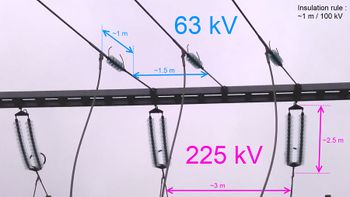
It's possible to determine the value of built-in voltage=* of a power line by looking at two main design constraints:
- First, insulation chains' length
- Secondly, conductors spacing.
The main rule is just like that : about 1m per 100 kV.
According to picture, all the mapper has to do is looking at common power voltages running in its country to see which is the closest value for 1m and 2.5m.
In France :
- 1m = 100 kV => 90 kV or 63 kV depending of the place you're located in.
- 2.5m = 250 kV => 225 kV for regional power lines in the whole mainland.
To be more accurate, it is possible to look on tower's base where the voltage is often available.
Aditionnal stuff
Integrated junction box

Every power lines are composed of sections abutted one after the other with junctions. When underground, each junction can be placed in a concrete box as for easing later access and protect the junction itself.
Let's introduce power=junction to map such junction boxes when we can see them during construction works.
You can see an example | here.
Markers
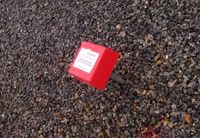
Surface markers indicating the presence of such an underground power line should be mapped with the new value power=marker as suggested twice in the first vote process.
Connections
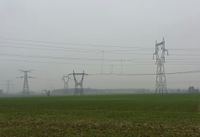
Connections between lines often occurs and two different circumstances : in free air or directly on supports, poles or towers.
They can be mapped with power=connection when occurring without support.
Have a look to this chapter to see how to map when on tower or poles.
Neutral distribution
Neutral conductor is a component of AC lines which may be present or not.
Typically on high voltage lines, operators would often choose not to add it because it's expensive. Earth will be the only way for power to go back to power plants and it's better like this.
But neutral will be there on local distribution lines, thus cables=* won't only reflect how many phases/poles we have on that particular lines.
neutral_conductors=* will be useful to precise :
- If neutral conductor is part of the line or not
- How manywe have to remove from
cables=*to know how many phases are part of the AC line or how many poles are part of a DC line.
Furthermore, please note when neutral conductor is part of the line, voltage=* should be given between that neutral conductor and phases.
For example, French local distribution lines are 400 V between phases but 220 V between a single phase and neutral conductor. In this particular case, voltage=* should have value 220 V.
Guidelines for line mapping
To avoid confusion in routing and navigation tools, we must adopt strict guidelines to map power lines (like any other linear stuff like roads or railroads).
One line = one situation
Each ![]()
power=line must group features with the same characteristics, especially the same number of circuits.
When a tag key or value changes (or needs to be added/removed), the line feature must end and a new line start so that the properties can be correctly tagged, just as with any other feature in OSM.
Layer distinguishing
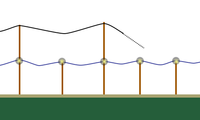
As ![]() Alv (on osm, edits, contrib, heatmap, chngset com.) suggested on talk,
Alv (on osm, edits, contrib, heatmap, chngset com.) suggested on talk, layer=* is needed when there are two different ![]()
power=line partially sharing some of the poles on some stretch, like in the image on the left. (In the past some suggested not to map these as two ways, but that seems wrong when the other line doesn't touch all the nodes, yet the other line has to touch all of the pole nodes.
Their circuits are not directly connected here. The line mounted higher is maybe 10 to 25 kV, and the lower line (probably 400V) has more densely spaced poles because of the street/footway lamps it feeds. A power line way should only touch the pole/tower nodes that the conductors "touch" (via the insulators, naturally).
The elevation hardly ever corresponds to a building level, except where the line penetrates the wall of the building it was built to feed.
This situation differs when two or several circuits (even from different voltages) shares exactly the same supports and must be mapped as a single power=line.
Values to be replaced
All other values of power=* (power=minor_underground_cable, power=underground_cable, ...) should be replaced as below:
| Obsolete tag | Used for ? | New tag(s) to use |
|---|---|---|
power=minor_line |
Low voltage line | power=line + voltage=* + usage=minor_distribution
|
power=underground_cable |
Underground cable | power=cable + location=underground
|
power=underground_cable |
Sea cable | power=cable + location=undersea. Please notice that a line could be under the sea floor, such case should be treated like classical terrestrial underground lines with location=underground.
|
power=minor_underground_cable |
Low voltage underground cable | power=cable + location=underground + voltage=* + usage=minor_distribution
|
tunnel=yes |
Power cables hosted in a human accessible tunnel | location=tunnel
|
This table is a guideline for replacement only. Take it with caution and don't do mass edit.
Examples
Let's try to expose current projects, maybe under construction, and legacy ones to give useful case studies to mappers.
20 kV overhead distribution lines
More information:
|
|
French "Cotentin-Maine" 400 kV project
Contentin-Main project is a power line built as for improve power transit from Flamanville new PWR nuclear reactor. It consists in a 100% overhead lines, two 3 phases circuits linked to power substations of French power grid operator, RTE France.
More information:
|
|
Underground power lines : Annecy'nergie 2013
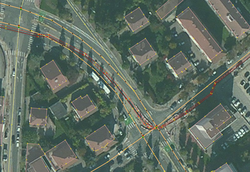
Annecy'nergie 2013 is another project conduced by RTE and it aims to put underground all suburbs overhead lines, like in many other French cities.
Furthermore, some substations were created to sustain increasing place demand of electricity.
|
More information:
- OSM : http://www.openstreetmap.org/?lat=45.90273097157478&lon=6.111064553260803&zoom=18
- Proposal conformity changeset : http://www.openstreetmap.org/browse/changeset/16753941
- Topological infos could be find here : http://www.rte-france.com/uploads/media/images/projets/plaquette_riverain_VDEF.pdf
Local power distribution lines
Such local lines support power transit between last transformer to consumers.
They can run along roads or be underground, especially in cities or suburbs
When distribution is done with alternative current, a neutral conductor is part of the lines.
Voltage is here given between neutral and phase !
|
Typical HVDC power line
HVDC power lines are used to carry power at high voltage and through long distances.
They are currently highly recommended due to the massive intercontinental power lines roll-out.
|
More information:
- OSM : http://www.openstreetmap.org/browse/way/242127520
- Proposal conformity changeset : http://www.openstreetmap.org/browse/changeset/18357639
Features/Pages affected
Reference pages
power=*: Update the page and features list.power=line: Update the page.power=cable: Update this page.power=minor_line: Update the page : indicate this value should be replaced bypower=line+usage=minor_distribution+voltage=*and remove it from power features page.neutral_conductors=*: Add topower=linepage.power=junction: Create this page and add it to the power features page.power=marker: Add topower=cablepage and add it to the power features page.power=connection: Create the page, documentconnection=*too and add it to the power features page.usage=*: Update the page and add values dedicated to power domain.
Descriptive pages
- WikiProject_Power_networks : Split the page between different kind of power concerned.
- Power_lines : Merge the page with WikiProject_Power_networks
- Power : Merge the page with WikiProject_Power_networks
Rendering and Tools/Renderers affected
power=linefeatures should be rendered only when they are located overhead. Common rendering rules may choose to avoid underground/sea stuff (or show them with light dashes) since they can't be seen by people. Special theme maps can adapt rendering to show the location difference.power=linefeatures thickness on maps should be computed fromvoltage=*value : high voltage lines should be rendered a bit wider than low voltage ones, as now withpower=minor_line.power=poleshould be rendered with a big plain grey dot instead ofpower=towerwhich can be rendered the same as now.
Tools
- JOSM : Update presets for underground lines (post approval ticket creation)
- ID : Idem
Render
- Update mapnik / mapCSS definitions to show power lines as described above.
- Update at least the following other stylesheets similarly: openstreetbrowser.org, freietonne.de, 4umaps.eu, hikebikemap.de, openstreetmap.de "OSM deustscher stil" style, Reit- und Wanderkarte, latlon.org, osmorg.crite.net, openorienteeringmap "Pseud-O" style, their own style at lightmap.uni-hd.de, and wikimedia toolserver(?) "black and white osm".
Comments
Please post in the discussion page for any comments.
Voting
Voting has not started yet.